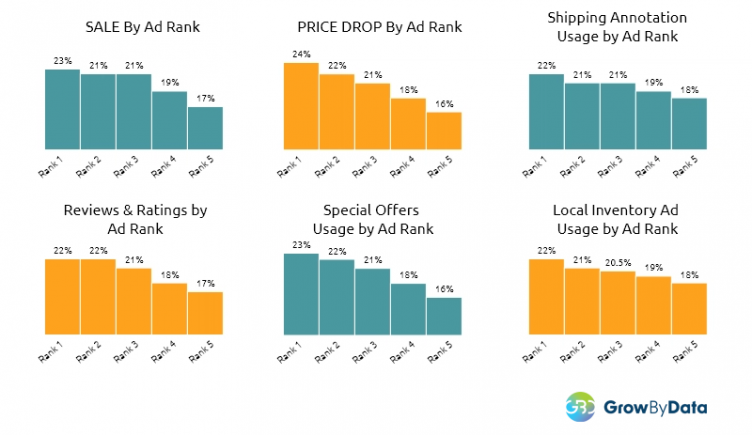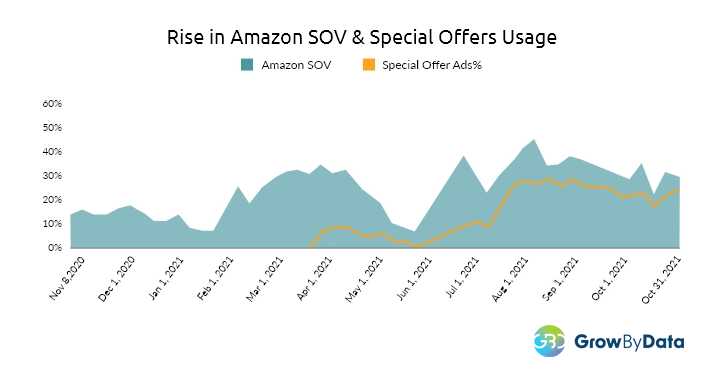The past couple of holiday seasons has proven to be extremely unique, unprecedented, and unpredictable presenting complications for eCommerce retailers and advertisers. As we come to the end of the 2021 holiday season, reflecting on the learnings from the season will be crucial to the success of your business in the future.
Using our Search Intelligence Software solution, we collected and analyzed over 35M ads from 14,000 keywords across 17 different categories on Google and Amazon during the 2021 holiday season (November and December). Below, we present some insights and lessons that we learned from analyzing the ad data this holiday season.
Table of Contents: Show
Marketplaces like Google and Amazon are continuously striving to improve the quality of the ads presented to shopper to improve their shopping experience. Presenting ads most relevant to the user’s search can result in higher clicks and lower CPC (cost-per-click). As shown on the graph below, the click rate is much higher (27%), and the CPC is significantly lower ($0.4) on ads with a quality score in the 9-10 range on the Google marketplace.

Two ways to improve the quality score are:
- Using Extensions, Annotations, and Labels to improve the CTR
- Optimizing the ad content across the digital shelf and across the shopper journey to increase ad relevance and ad performance
Using Extensions, Annotations, and Labels to improve the CTR
Extensions, annotations, and labels are additional content displayed on the ads apart from the title, price, image, and store/brand name that helps your ads stand out in the search results, enticing shoppers to click on your product over your competitors.
The graph below shows the use of Google ad extensions and annotation across all the categories on Google during the 2021 holiday season. Extensions like reviews & ratings, shipping labels, and special offers were used on more than 20% of the overall ads. But the use of local inventory ads (LIA), sale, and price drops was below 10%. Having features like special offers, sales, shipping annotations, reviews & ratings, etc., will give you a better chance of getting more impressions, clicks, higher rank, and overall better eCommerce performance.
Looking closer at just the above-the-fold ads, which are the most coveted spots for advertisers, we found the usage of all the extensions and annotations to be much higher. The largest differences (between usage on total ads and above the fold) were in the use of LIA (local inventory ads), sales, and price drop as shown on the graph below.

Analyzing the data on the Amazon marketplace, we found that almost 80% of the ads in the top 10 that won the buy box had more than 100 reviews on it, and 90% of the buy box winners had a rating of higher than 3 as shown on the graph below. Another way the buy box winners stood out was by having ‘free shipping’. Per the graph below, 90% of the buy box winners were utilizing this feature on their ads.

Ad Extensions and annotations Impact on Ad Rank and Share of Voice
A quick look at the graph with Advertising Intelligence Data below tells us that there is a downward trend in the use of all the extensions and annotations as we move down the rankings on Google. This means that if your ads have made use of extensions and labels, your probability of ranking higher will be better.

Our data also shows that Amazon heavily utilized and invested in increasing the use of special promotion extensions on their ads to increase their share of voice in the food and beverage category as shown on the graphs below.

Optimizing the ad content across the digital shelf and across the shopper journey to increase ad relevance and ad performance
Product Intelligence provides you with insights to improve the buying ability of your products. Utilizing a tool like this to get your product detail page scores (PDP)/report allows you to see what content of your ad is underperforming. Looking at the scores this way (image below) minimizes wasted effort since you know exactly what to work on. This is how PDP scores can be used to improve ad content to get more clicks, leading to a better rank, thus improving your quality score on Google.

Another way to improve your buy-ability is by enriching product titles and descriptions with keywords such as brand name, variants (color, material, size), demography (age, gender), model number, manufacturer part number, etc. These features not only increase Ad Impressions but also reduce Max Bid for a better Ad Rank while increasing your Quality Score, for those important keywords which your digital shopper most likely uses in their search queries. As shown in the graph below, ads on the first page of the Amazon SERP have an extremely high usage of shopper attributes in the title.

Conclusion
The 2021 holiday season showed that despite several factors negatively impacting the season for online retailers and advertisers, consumers did not slow down their holiday shopping. The pandemic has moved more businesses online than ever before causing the online retail and ad industry to be more competitive. Therefore, online advertisers need to take this opportunity to leverage the data and insights from this holiday season to better prepare for the next year.


